Financial Accounting Report: Principles, Calculations, and Analysis
VerifiedAdded on 2020/10/05
|28
|4256
|429
Report
AI Summary
This comprehensive financial accounting report provides a detailed overview of the subject, starting with the definition and purpose of financial accounting and its importance in providing useful financial information. It explores the regulations governing financial accounting, including the roles of IASB and IFRS, and delves into various accounting rules and principles such as the debit and credit system, conservatism, and the going concern principle. The report also discusses conventions and concepts like consistency, material disclosure, and accrual accounting. Furthermore, it includes practical applications through client-based examples, covering the double-entry system, profit and loss accounts, bank reconciliation statements, and various accounting entries, providing a well-rounded understanding of financial accounting principles and practices. The report concludes with a summary of the key concepts discussed.
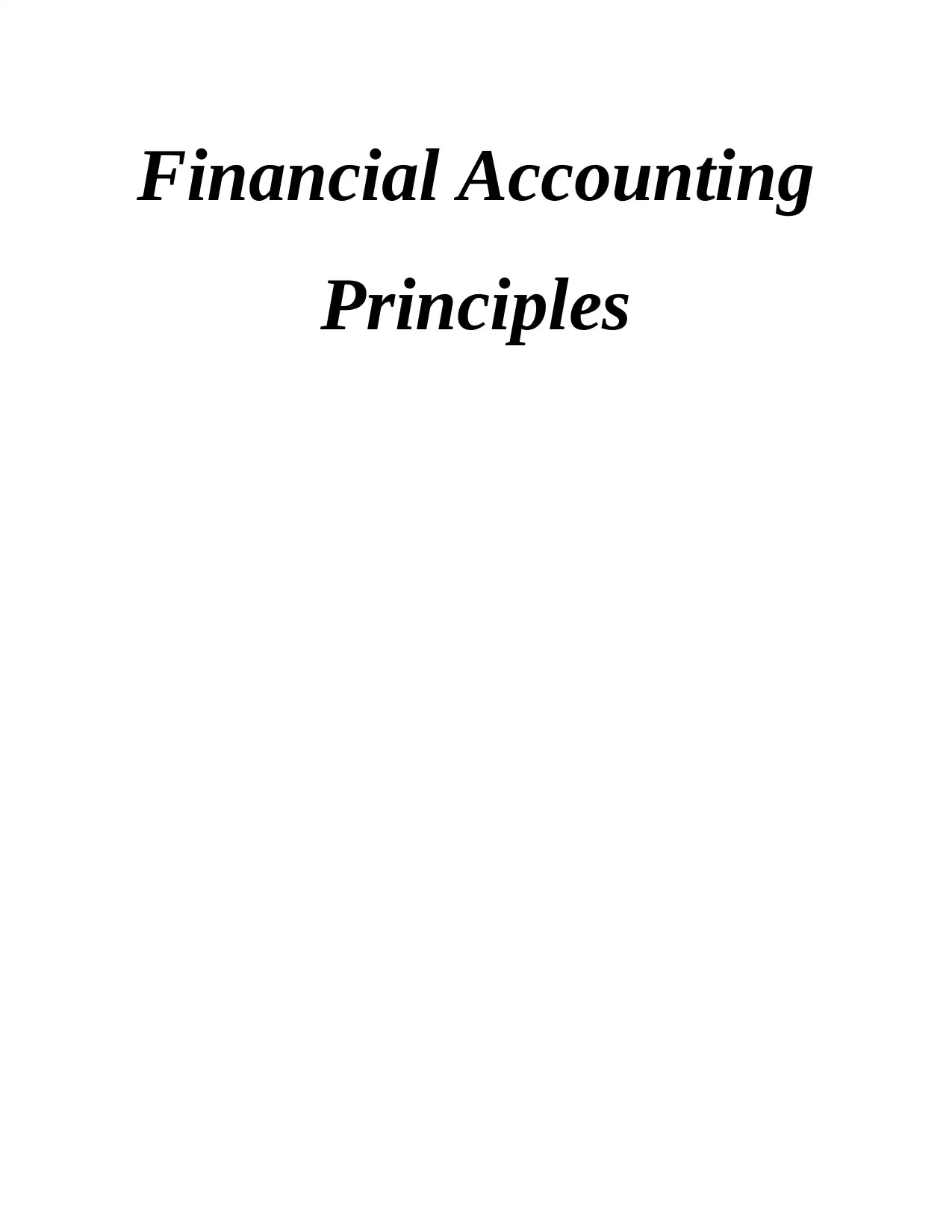
Financial Accounting
Principles
Principles
Paraphrase This Document
Need a fresh take? Get an instant paraphrase of this document with our AI Paraphraser
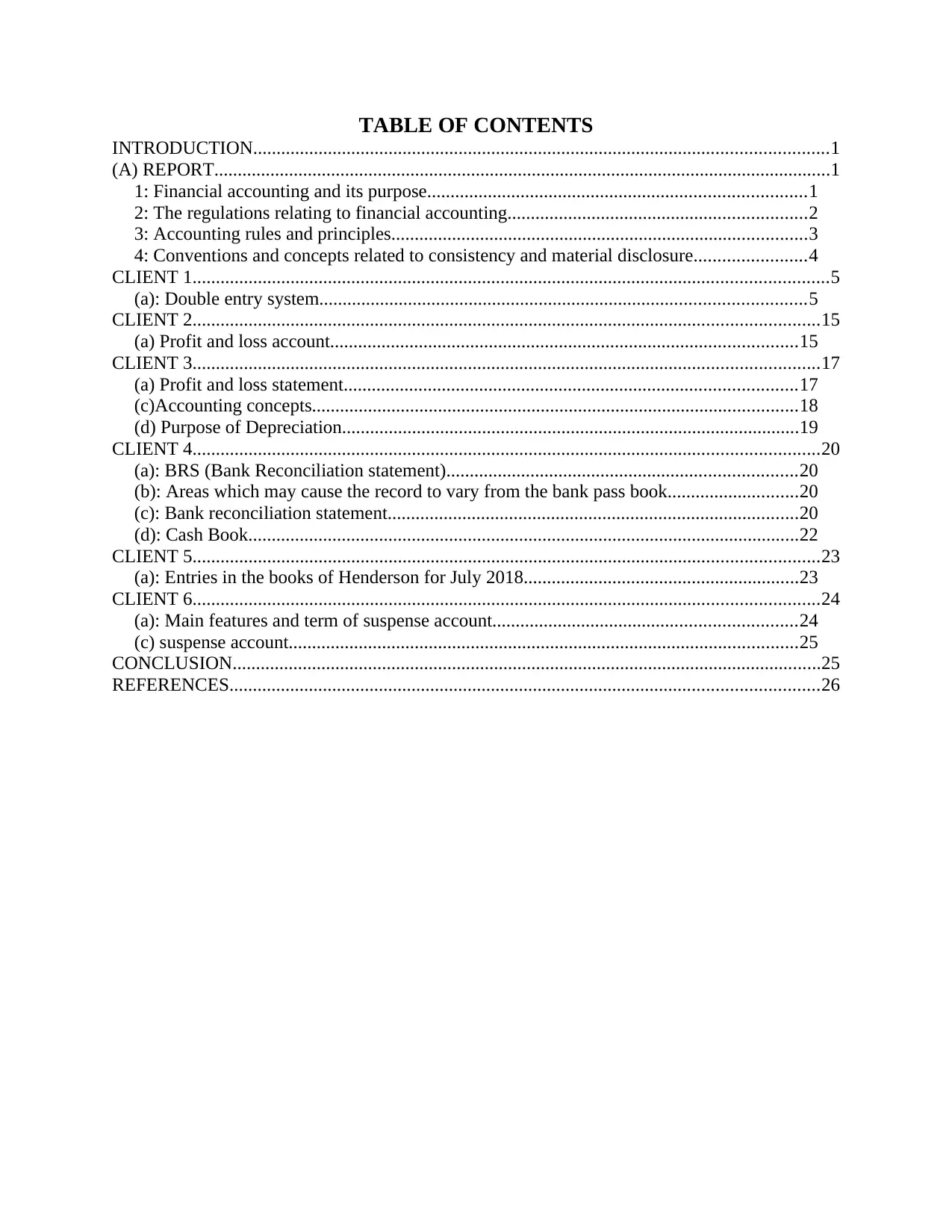
TABLE OF CONTENTS
INTRODUCTION...........................................................................................................................1
(A) REPORT....................................................................................................................................1
1: Financial accounting and its purpose.................................................................................1
2: The regulations relating to financial accounting................................................................2
3: Accounting rules and principles.........................................................................................3
4: Conventions and concepts related to consistency and material disclosure........................4
CLIENT 1........................................................................................................................................5
(a): Double entry system........................................................................................................5
CLIENT 2......................................................................................................................................15
(a) Profit and loss account....................................................................................................15
CLIENT 3......................................................................................................................................17
(a) Profit and loss statement.................................................................................................17
(c)Accounting concepts........................................................................................................18
(d) Purpose of Depreciation..................................................................................................19
CLIENT 4......................................................................................................................................20
(a): BRS (Bank Reconciliation statement)...........................................................................20
(b): Areas which may cause the record to vary from the bank pass book............................20
(c): Bank reconciliation statement........................................................................................20
(d): Cash Book......................................................................................................................22
CLIENT 5......................................................................................................................................23
(a): Entries in the books of Henderson for July 2018...........................................................23
CLIENT 6......................................................................................................................................24
(a): Main features and term of suspense account.................................................................24
(c) suspense account.............................................................................................................25
CONCLUSION..............................................................................................................................25
REFERENCES..............................................................................................................................26
INTRODUCTION...........................................................................................................................1
(A) REPORT....................................................................................................................................1
1: Financial accounting and its purpose.................................................................................1
2: The regulations relating to financial accounting................................................................2
3: Accounting rules and principles.........................................................................................3
4: Conventions and concepts related to consistency and material disclosure........................4
CLIENT 1........................................................................................................................................5
(a): Double entry system........................................................................................................5
CLIENT 2......................................................................................................................................15
(a) Profit and loss account....................................................................................................15
CLIENT 3......................................................................................................................................17
(a) Profit and loss statement.................................................................................................17
(c)Accounting concepts........................................................................................................18
(d) Purpose of Depreciation..................................................................................................19
CLIENT 4......................................................................................................................................20
(a): BRS (Bank Reconciliation statement)...........................................................................20
(b): Areas which may cause the record to vary from the bank pass book............................20
(c): Bank reconciliation statement........................................................................................20
(d): Cash Book......................................................................................................................22
CLIENT 5......................................................................................................................................23
(a): Entries in the books of Henderson for July 2018...........................................................23
CLIENT 6......................................................................................................................................24
(a): Main features and term of suspense account.................................................................24
(c) suspense account.............................................................................................................25
CONCLUSION..............................................................................................................................25
REFERENCES..............................................................................................................................26
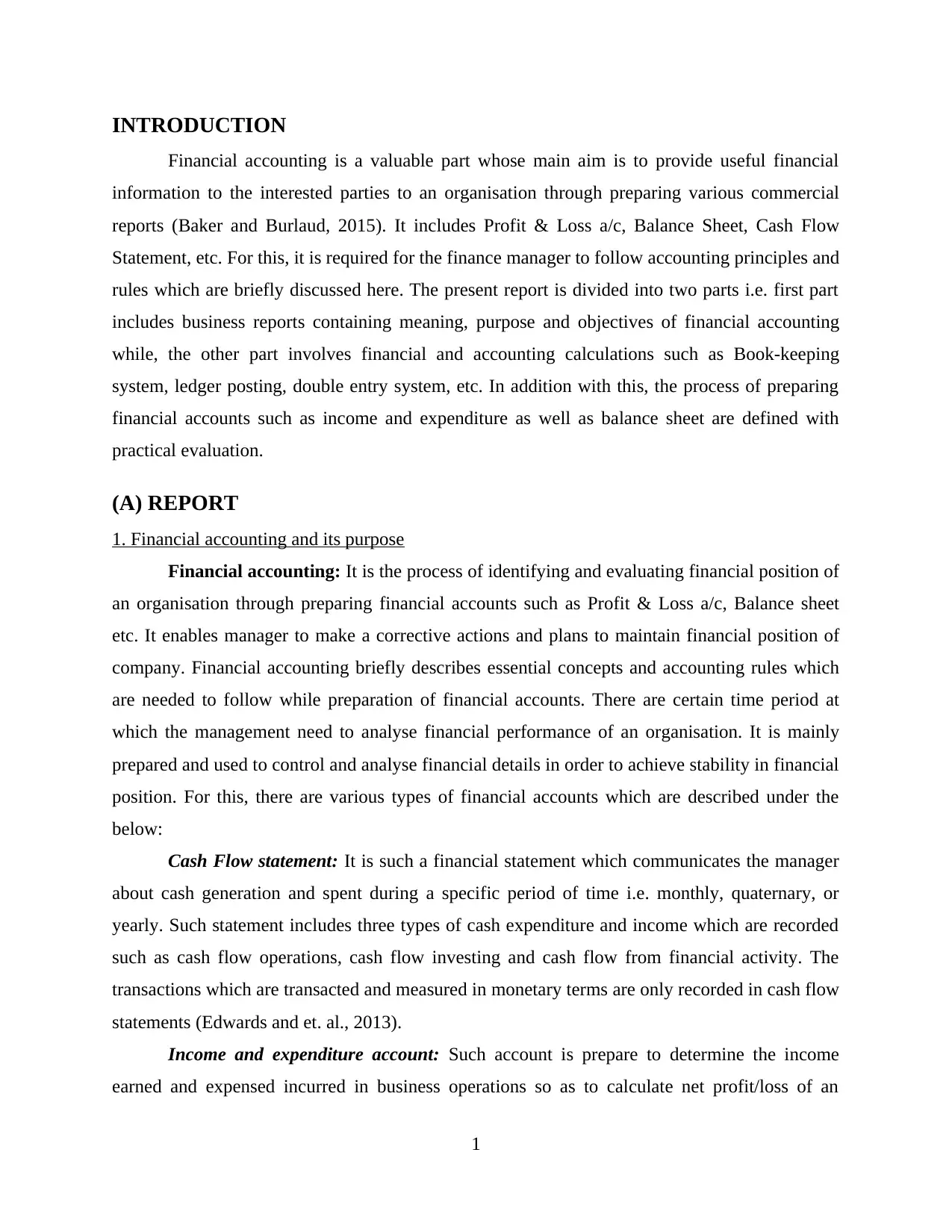
INTRODUCTION
Financial accounting is a valuable part whose main aim is to provide useful financial
information to the interested parties to an organisation through preparing various commercial
reports (Baker and Burlaud, 2015). It includes Profit & Loss a/c, Balance Sheet, Cash Flow
Statement, etc. For this, it is required for the finance manager to follow accounting principles and
rules which are briefly discussed here. The present report is divided into two parts i.e. first part
includes business reports containing meaning, purpose and objectives of financial accounting
while, the other part involves financial and accounting calculations such as Book-keeping
system, ledger posting, double entry system, etc. In addition with this, the process of preparing
financial accounts such as income and expenditure as well as balance sheet are defined with
practical evaluation.
(A) REPORT
1. Financial accounting and its purpose
Financial accounting: It is the process of identifying and evaluating financial position of
an organisation through preparing financial accounts such as Profit & Loss a/c, Balance sheet
etc. It enables manager to make a corrective actions and plans to maintain financial position of
company. Financial accounting briefly describes essential concepts and accounting rules which
are needed to follow while preparation of financial accounts. There are certain time period at
which the management need to analyse financial performance of an organisation. It is mainly
prepared and used to control and analyse financial details in order to achieve stability in financial
position. For this, there are various types of financial accounts which are described under the
below:
Cash Flow statement: It is such a financial statement which communicates the manager
about cash generation and spent during a specific period of time i.e. monthly, quaternary, or
yearly. Such statement includes three types of cash expenditure and income which are recorded
such as cash flow operations, cash flow investing and cash flow from financial activity. The
transactions which are transacted and measured in monetary terms are only recorded in cash flow
statements (Edwards and et. al., 2013).
Income and expenditure account: Such account is prepare to determine the income
earned and expensed incurred in business operations so as to calculate net profit/loss of an
1
Financial accounting is a valuable part whose main aim is to provide useful financial
information to the interested parties to an organisation through preparing various commercial
reports (Baker and Burlaud, 2015). It includes Profit & Loss a/c, Balance Sheet, Cash Flow
Statement, etc. For this, it is required for the finance manager to follow accounting principles and
rules which are briefly discussed here. The present report is divided into two parts i.e. first part
includes business reports containing meaning, purpose and objectives of financial accounting
while, the other part involves financial and accounting calculations such as Book-keeping
system, ledger posting, double entry system, etc. In addition with this, the process of preparing
financial accounts such as income and expenditure as well as balance sheet are defined with
practical evaluation.
(A) REPORT
1. Financial accounting and its purpose
Financial accounting: It is the process of identifying and evaluating financial position of
an organisation through preparing financial accounts such as Profit & Loss a/c, Balance sheet
etc. It enables manager to make a corrective actions and plans to maintain financial position of
company. Financial accounting briefly describes essential concepts and accounting rules which
are needed to follow while preparation of financial accounts. There are certain time period at
which the management need to analyse financial performance of an organisation. It is mainly
prepared and used to control and analyse financial details in order to achieve stability in financial
position. For this, there are various types of financial accounts which are described under the
below:
Cash Flow statement: It is such a financial statement which communicates the manager
about cash generation and spent during a specific period of time i.e. monthly, quaternary, or
yearly. Such statement includes three types of cash expenditure and income which are recorded
such as cash flow operations, cash flow investing and cash flow from financial activity. The
transactions which are transacted and measured in monetary terms are only recorded in cash flow
statements (Edwards and et. al., 2013).
Income and expenditure account: Such account is prepare to determine the income
earned and expensed incurred in business operations so as to calculate net profit/loss of an
1
⊘ This is a preview!⊘
Do you want full access?
Subscribe today to unlock all pages.

Trusted by 1+ million students worldwide
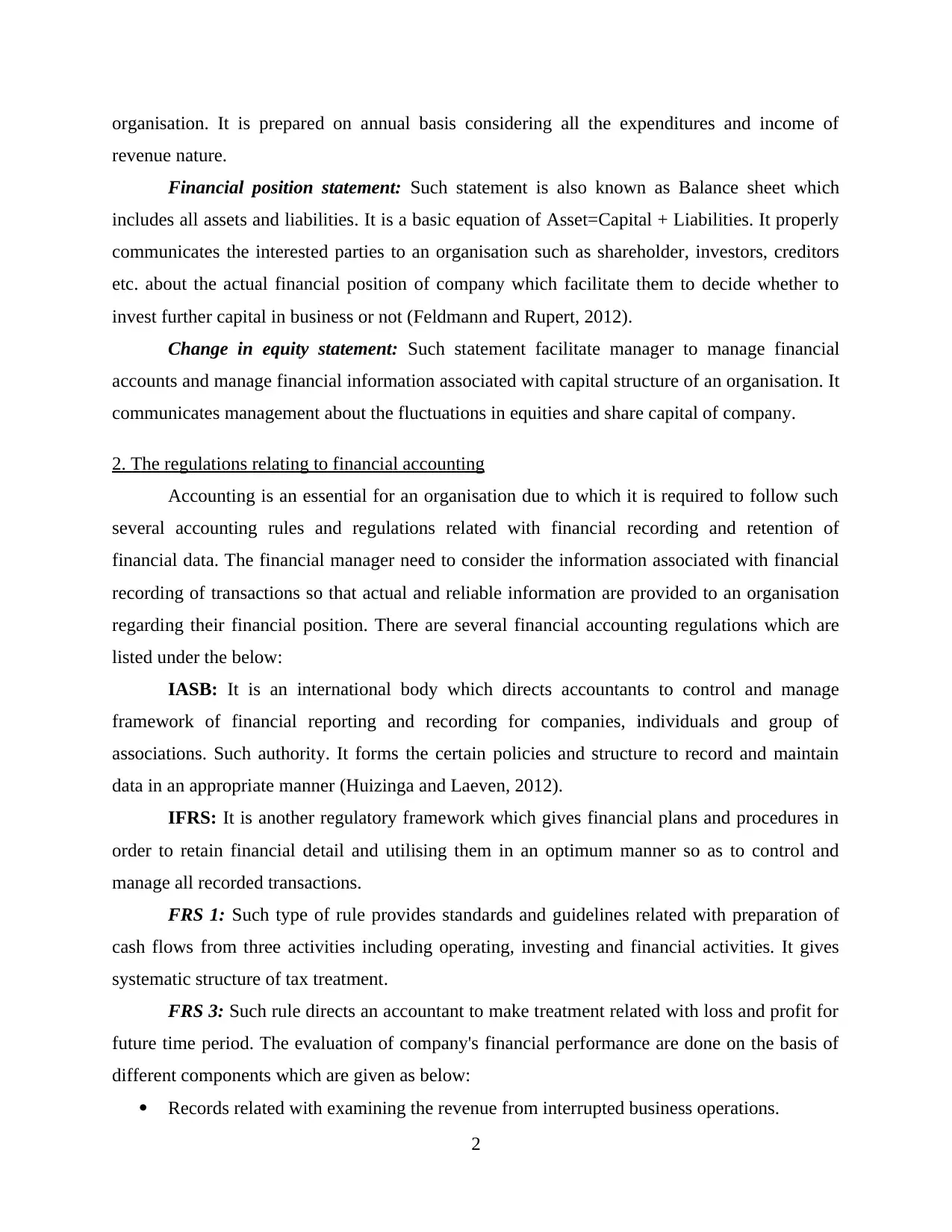
organisation. It is prepared on annual basis considering all the expenditures and income of
revenue nature.
Financial position statement: Such statement is also known as Balance sheet which
includes all assets and liabilities. It is a basic equation of Asset=Capital + Liabilities. It properly
communicates the interested parties to an organisation such as shareholder, investors, creditors
etc. about the actual financial position of company which facilitate them to decide whether to
invest further capital in business or not (Feldmann and Rupert, 2012).
Change in equity statement: Such statement facilitate manager to manage financial
accounts and manage financial information associated with capital structure of an organisation. It
communicates management about the fluctuations in equities and share capital of company.
2. The regulations relating to financial accounting
Accounting is an essential for an organisation due to which it is required to follow such
several accounting rules and regulations related with financial recording and retention of
financial data. The financial manager need to consider the information associated with financial
recording of transactions so that actual and reliable information are provided to an organisation
regarding their financial position. There are several financial accounting regulations which are
listed under the below:
IASB: It is an international body which directs accountants to control and manage
framework of financial reporting and recording for companies, individuals and group of
associations. Such authority. It forms the certain policies and structure to record and maintain
data in an appropriate manner (Huizinga and Laeven, 2012).
IFRS: It is another regulatory framework which gives financial plans and procedures in
order to retain financial detail and utilising them in an optimum manner so as to control and
manage all recorded transactions.
FRS 1: Such type of rule provides standards and guidelines related with preparation of
cash flows from three activities including operating, investing and financial activities. It gives
systematic structure of tax treatment.
FRS 3: Such rule directs an accountant to make treatment related with loss and profit for
future time period. The evaluation of company's financial performance are done on the basis of
different components which are given as below:
Records related with examining the revenue from interrupted business operations.
2
revenue nature.
Financial position statement: Such statement is also known as Balance sheet which
includes all assets and liabilities. It is a basic equation of Asset=Capital + Liabilities. It properly
communicates the interested parties to an organisation such as shareholder, investors, creditors
etc. about the actual financial position of company which facilitate them to decide whether to
invest further capital in business or not (Feldmann and Rupert, 2012).
Change in equity statement: Such statement facilitate manager to manage financial
accounts and manage financial information associated with capital structure of an organisation. It
communicates management about the fluctuations in equities and share capital of company.
2. The regulations relating to financial accounting
Accounting is an essential for an organisation due to which it is required to follow such
several accounting rules and regulations related with financial recording and retention of
financial data. The financial manager need to consider the information associated with financial
recording of transactions so that actual and reliable information are provided to an organisation
regarding their financial position. There are several financial accounting regulations which are
listed under the below:
IASB: It is an international body which directs accountants to control and manage
framework of financial reporting and recording for companies, individuals and group of
associations. Such authority. It forms the certain policies and structure to record and maintain
data in an appropriate manner (Huizinga and Laeven, 2012).
IFRS: It is another regulatory framework which gives financial plans and procedures in
order to retain financial detail and utilising them in an optimum manner so as to control and
manage all recorded transactions.
FRS 1: Such type of rule provides standards and guidelines related with preparation of
cash flows from three activities including operating, investing and financial activities. It gives
systematic structure of tax treatment.
FRS 3: Such rule directs an accountant to make treatment related with loss and profit for
future time period. The evaluation of company's financial performance are done on the basis of
different components which are given as below:
Records related with examining the revenue from interrupted business operations.
2
Paraphrase This Document
Need a fresh take? Get an instant paraphrase of this document with our AI Paraphraser
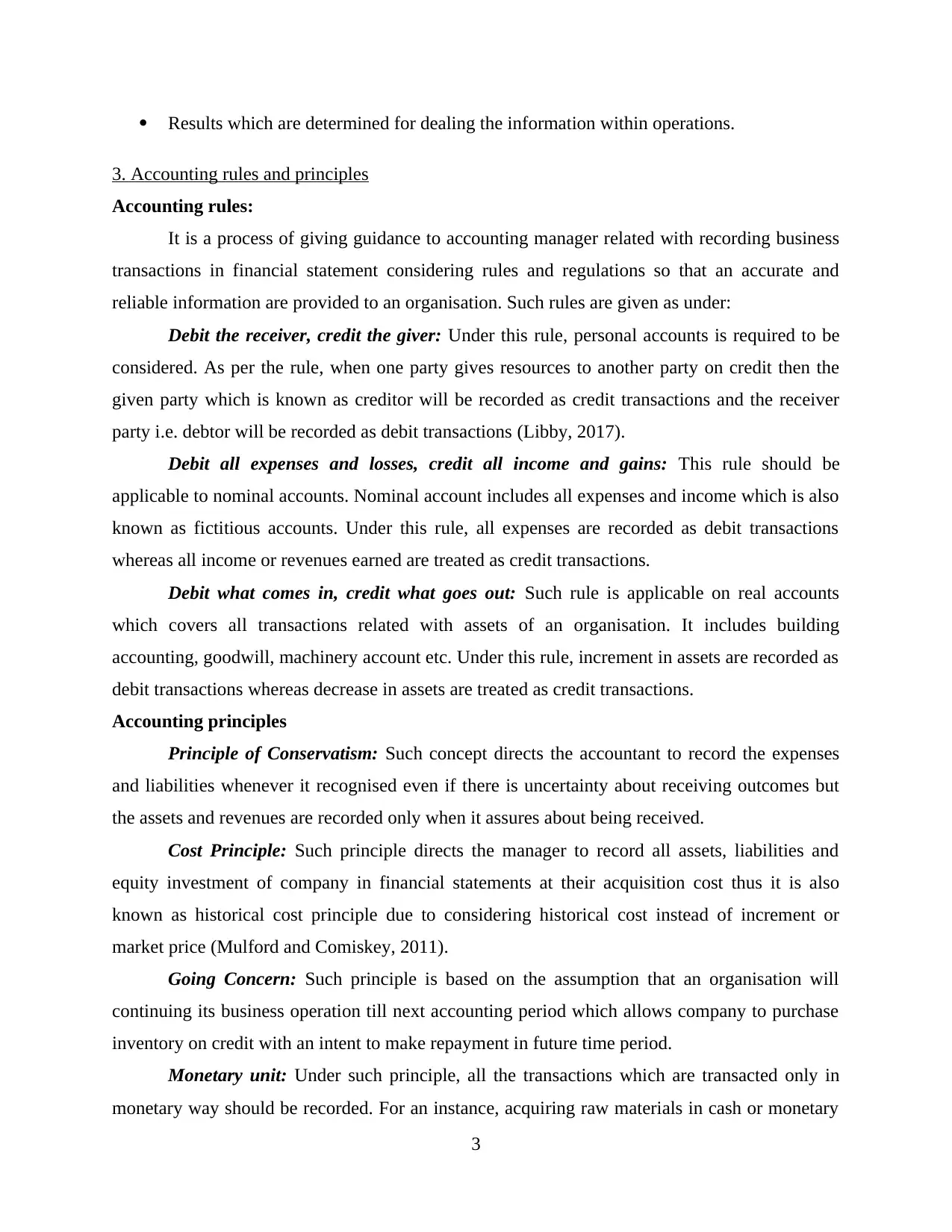
Results which are determined for dealing the information within operations.
3. Accounting rules and principles
Accounting rules:
It is a process of giving guidance to accounting manager related with recording business
transactions in financial statement considering rules and regulations so that an accurate and
reliable information are provided to an organisation. Such rules are given as under:
Debit the receiver, credit the giver: Under this rule, personal accounts is required to be
considered. As per the rule, when one party gives resources to another party on credit then the
given party which is known as creditor will be recorded as credit transactions and the receiver
party i.e. debtor will be recorded as debit transactions (Libby, 2017).
Debit all expenses and losses, credit all income and gains: This rule should be
applicable to nominal accounts. Nominal account includes all expenses and income which is also
known as fictitious accounts. Under this rule, all expenses are recorded as debit transactions
whereas all income or revenues earned are treated as credit transactions.
Debit what comes in, credit what goes out: Such rule is applicable on real accounts
which covers all transactions related with assets of an organisation. It includes building
accounting, goodwill, machinery account etc. Under this rule, increment in assets are recorded as
debit transactions whereas decrease in assets are treated as credit transactions.
Accounting principles
Principle of Conservatism: Such concept directs the accountant to record the expenses
and liabilities whenever it recognised even if there is uncertainty about receiving outcomes but
the assets and revenues are recorded only when it assures about being received.
Cost Principle: Such principle directs the manager to record all assets, liabilities and
equity investment of company in financial statements at their acquisition cost thus it is also
known as historical cost principle due to considering historical cost instead of increment or
market price (Mulford and Comiskey, 2011).
Going Concern: Such principle is based on the assumption that an organisation will
continuing its business operation till next accounting period which allows company to purchase
inventory on credit with an intent to make repayment in future time period.
Monetary unit: Under such principle, all the transactions which are transacted only in
monetary way should be recorded. For an instance, acquiring raw materials in cash or monetary
3
3. Accounting rules and principles
Accounting rules:
It is a process of giving guidance to accounting manager related with recording business
transactions in financial statement considering rules and regulations so that an accurate and
reliable information are provided to an organisation. Such rules are given as under:
Debit the receiver, credit the giver: Under this rule, personal accounts is required to be
considered. As per the rule, when one party gives resources to another party on credit then the
given party which is known as creditor will be recorded as credit transactions and the receiver
party i.e. debtor will be recorded as debit transactions (Libby, 2017).
Debit all expenses and losses, credit all income and gains: This rule should be
applicable to nominal accounts. Nominal account includes all expenses and income which is also
known as fictitious accounts. Under this rule, all expenses are recorded as debit transactions
whereas all income or revenues earned are treated as credit transactions.
Debit what comes in, credit what goes out: Such rule is applicable on real accounts
which covers all transactions related with assets of an organisation. It includes building
accounting, goodwill, machinery account etc. Under this rule, increment in assets are recorded as
debit transactions whereas decrease in assets are treated as credit transactions.
Accounting principles
Principle of Conservatism: Such concept directs the accountant to record the expenses
and liabilities whenever it recognised even if there is uncertainty about receiving outcomes but
the assets and revenues are recorded only when it assures about being received.
Cost Principle: Such principle directs the manager to record all assets, liabilities and
equity investment of company in financial statements at their acquisition cost thus it is also
known as historical cost principle due to considering historical cost instead of increment or
market price (Mulford and Comiskey, 2011).
Going Concern: Such principle is based on the assumption that an organisation will
continuing its business operation till next accounting period which allows company to purchase
inventory on credit with an intent to make repayment in future time period.
Monetary unit: Under such principle, all the transactions which are transacted only in
monetary way should be recorded. For an instance, acquiring raw materials in cash or monetary
3
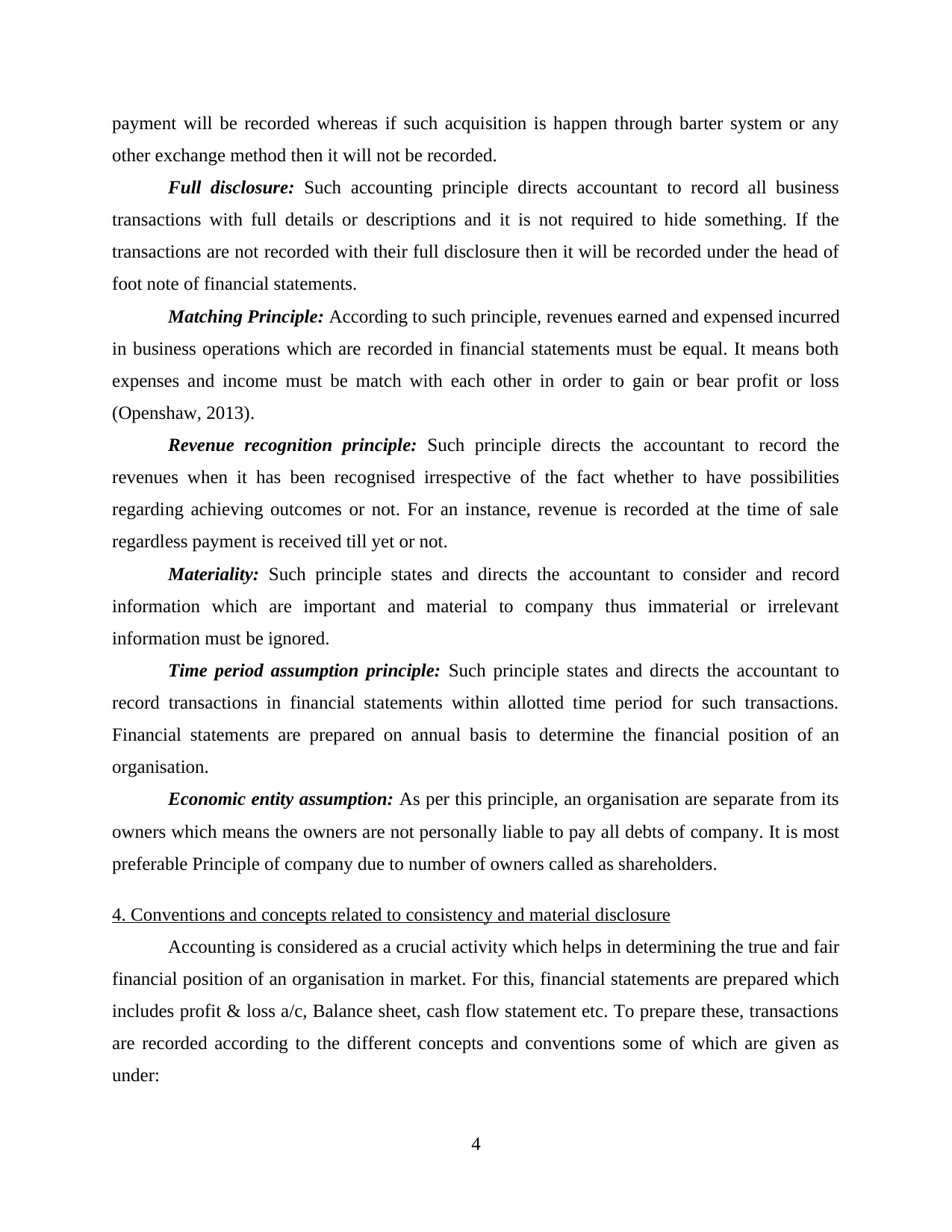
payment will be recorded whereas if such acquisition is happen through barter system or any
other exchange method then it will not be recorded.
Full disclosure: Such accounting principle directs accountant to record all business
transactions with full details or descriptions and it is not required to hide something. If the
transactions are not recorded with their full disclosure then it will be recorded under the head of
foot note of financial statements.
Matching Principle: According to such principle, revenues earned and expensed incurred
in business operations which are recorded in financial statements must be equal. It means both
expenses and income must be match with each other in order to gain or bear profit or loss
(Openshaw, 2013).
Revenue recognition principle: Such principle directs the accountant to record the
revenues when it has been recognised irrespective of the fact whether to have possibilities
regarding achieving outcomes or not. For an instance, revenue is recorded at the time of sale
regardless payment is received till yet or not.
Materiality: Such principle states and directs the accountant to consider and record
information which are important and material to company thus immaterial or irrelevant
information must be ignored.
Time period assumption principle: Such principle states and directs the accountant to
record transactions in financial statements within allotted time period for such transactions.
Financial statements are prepared on annual basis to determine the financial position of an
organisation.
Economic entity assumption: As per this principle, an organisation are separate from its
owners which means the owners are not personally liable to pay all debts of company. It is most
preferable Principle of company due to number of owners called as shareholders.
4. Conventions and concepts related to consistency and material disclosure
Accounting is considered as a crucial activity which helps in determining the true and fair
financial position of an organisation in market. For this, financial statements are prepared which
includes profit & loss a/c, Balance sheet, cash flow statement etc. To prepare these, transactions
are recorded according to the different concepts and conventions some of which are given as
under:
4
other exchange method then it will not be recorded.
Full disclosure: Such accounting principle directs accountant to record all business
transactions with full details or descriptions and it is not required to hide something. If the
transactions are not recorded with their full disclosure then it will be recorded under the head of
foot note of financial statements.
Matching Principle: According to such principle, revenues earned and expensed incurred
in business operations which are recorded in financial statements must be equal. It means both
expenses and income must be match with each other in order to gain or bear profit or loss
(Openshaw, 2013).
Revenue recognition principle: Such principle directs the accountant to record the
revenues when it has been recognised irrespective of the fact whether to have possibilities
regarding achieving outcomes or not. For an instance, revenue is recorded at the time of sale
regardless payment is received till yet or not.
Materiality: Such principle states and directs the accountant to consider and record
information which are important and material to company thus immaterial or irrelevant
information must be ignored.
Time period assumption principle: Such principle states and directs the accountant to
record transactions in financial statements within allotted time period for such transactions.
Financial statements are prepared on annual basis to determine the financial position of an
organisation.
Economic entity assumption: As per this principle, an organisation are separate from its
owners which means the owners are not personally liable to pay all debts of company. It is most
preferable Principle of company due to number of owners called as shareholders.
4. Conventions and concepts related to consistency and material disclosure
Accounting is considered as a crucial activity which helps in determining the true and fair
financial position of an organisation in market. For this, financial statements are prepared which
includes profit & loss a/c, Balance sheet, cash flow statement etc. To prepare these, transactions
are recorded according to the different concepts and conventions some of which are given as
under:
4
⊘ This is a preview!⊘
Do you want full access?
Subscribe today to unlock all pages.

Trusted by 1+ million students worldwide
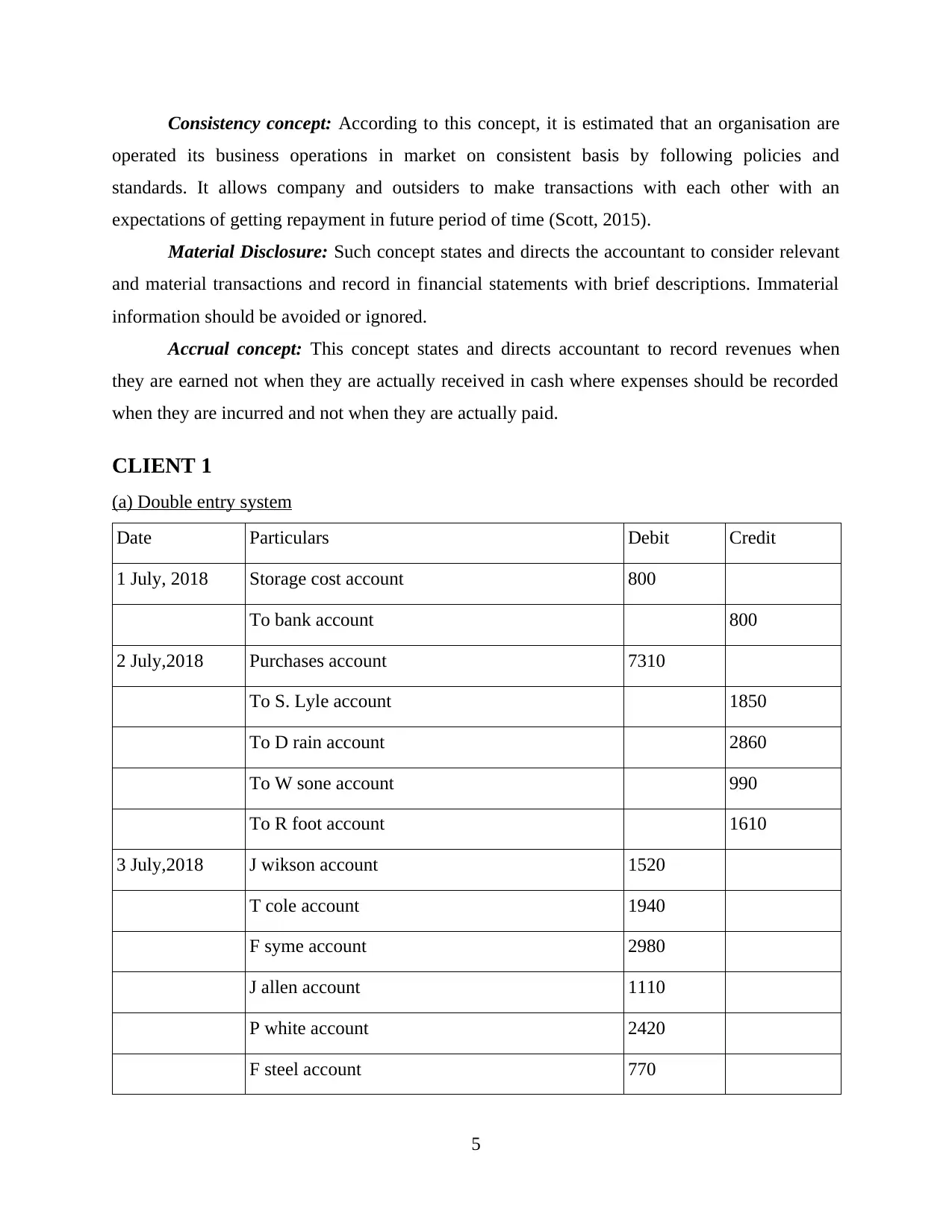
Consistency concept: According to this concept, it is estimated that an organisation are
operated its business operations in market on consistent basis by following policies and
standards. It allows company and outsiders to make transactions with each other with an
expectations of getting repayment in future period of time (Scott, 2015).
Material Disclosure: Such concept states and directs the accountant to consider relevant
and material transactions and record in financial statements with brief descriptions. Immaterial
information should be avoided or ignored.
Accrual concept: This concept states and directs accountant to record revenues when
they are earned not when they are actually received in cash where expenses should be recorded
when they are incurred and not when they are actually paid.
CLIENT 1
(a) Double entry system
Date Particulars Debit Credit
1 July, 2018 Storage cost account 800
To bank account 800
2 July,2018 Purchases account 7310
To S. Lyle account 1850
To D rain account 2860
To W sone account 990
To R foot account 1610
3 July,2018 J wikson account 1520
T cole account 1940
F syme account 2980
J allen account 1110
P white account 2420
F steel account 770
5
operated its business operations in market on consistent basis by following policies and
standards. It allows company and outsiders to make transactions with each other with an
expectations of getting repayment in future period of time (Scott, 2015).
Material Disclosure: Such concept states and directs the accountant to consider relevant
and material transactions and record in financial statements with brief descriptions. Immaterial
information should be avoided or ignored.
Accrual concept: This concept states and directs accountant to record revenues when
they are earned not when they are actually received in cash where expenses should be recorded
when they are incurred and not when they are actually paid.
CLIENT 1
(a) Double entry system
Date Particulars Debit Credit
1 July, 2018 Storage cost account 800
To bank account 800
2 July,2018 Purchases account 7310
To S. Lyle account 1850
To D rain account 2860
To W sone account 990
To R foot account 1610
3 July,2018 J wikson account 1520
T cole account 1940
F syme account 2980
J allen account 1110
P white account 2420
F steel account 770
5
Paraphrase This Document
Need a fresh take? Get an instant paraphrase of this document with our AI Paraphraser
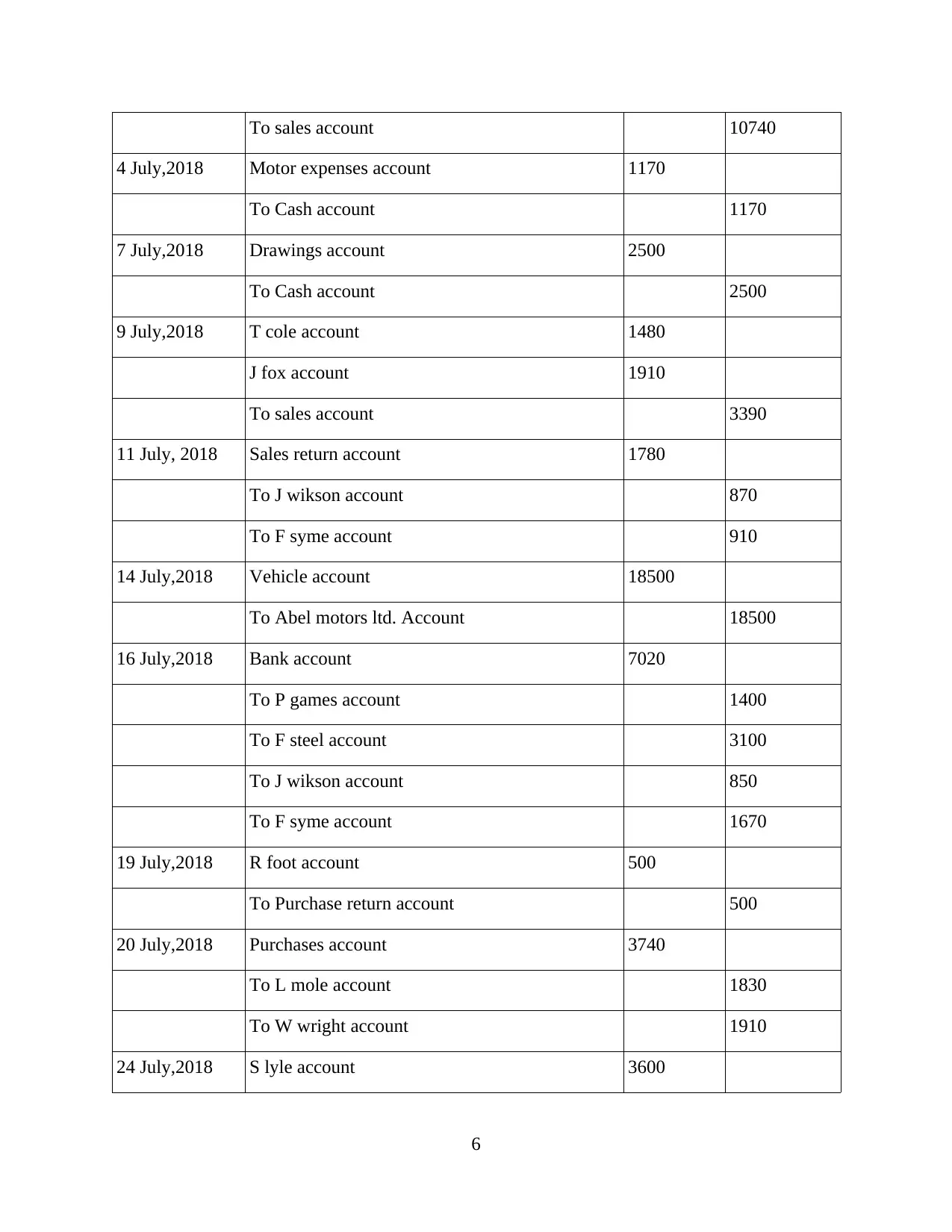
To sales account 10740
4 July,2018 Motor expenses account 1170
To Cash account 1170
7 July,2018 Drawings account 2500
To Cash account 2500
9 July,2018 T cole account 1480
J fox account 1910
To sales account 3390
11 July, 2018 Sales return account 1780
To J wikson account 870
To F syme account 910
14 July,2018 Vehicle account 18500
To Abel motors ltd. Account 18500
16 July,2018 Bank account 7020
To P games account 1400
To F steel account 3100
To J wikson account 850
To F syme account 1670
19 July,2018 R foot account 500
To Purchase return account 500
20 July,2018 Purchases account 3740
To L mole account 1830
To W wright account 1910
24 July,2018 S lyle account 3600
6
4 July,2018 Motor expenses account 1170
To Cash account 1170
7 July,2018 Drawings account 2500
To Cash account 2500
9 July,2018 T cole account 1480
J fox account 1910
To sales account 3390
11 July, 2018 Sales return account 1780
To J wikson account 870
To F syme account 910
14 July,2018 Vehicle account 18500
To Abel motors ltd. Account 18500
16 July,2018 Bank account 7020
To P games account 1400
To F steel account 3100
To J wikson account 850
To F syme account 1670
19 July,2018 R foot account 500
To Purchase return account 500
20 July,2018 Purchases account 3740
To L mole account 1830
To W wright account 1910
24 July,2018 S lyle account 3600
6
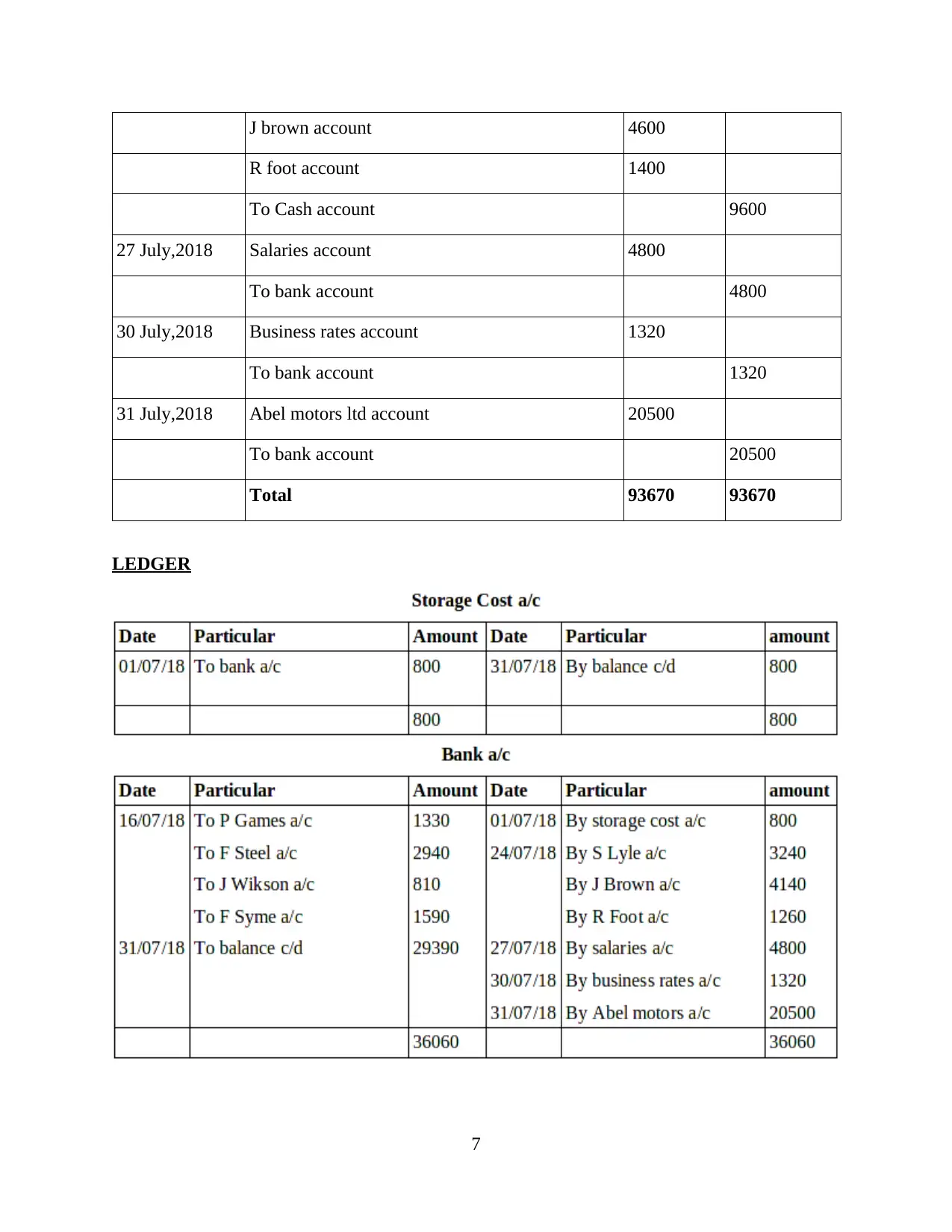
J brown account 4600
R foot account 1400
To Cash account 9600
27 July,2018 Salaries account 4800
To bank account 4800
30 July,2018 Business rates account 1320
To bank account 1320
31 July,2018 Abel motors ltd account 20500
To bank account 20500
Total 93670 93670
LEDGER
7
R foot account 1400
To Cash account 9600
27 July,2018 Salaries account 4800
To bank account 4800
30 July,2018 Business rates account 1320
To bank account 1320
31 July,2018 Abel motors ltd account 20500
To bank account 20500
Total 93670 93670
LEDGER
7
⊘ This is a preview!⊘
Do you want full access?
Subscribe today to unlock all pages.

Trusted by 1+ million students worldwide
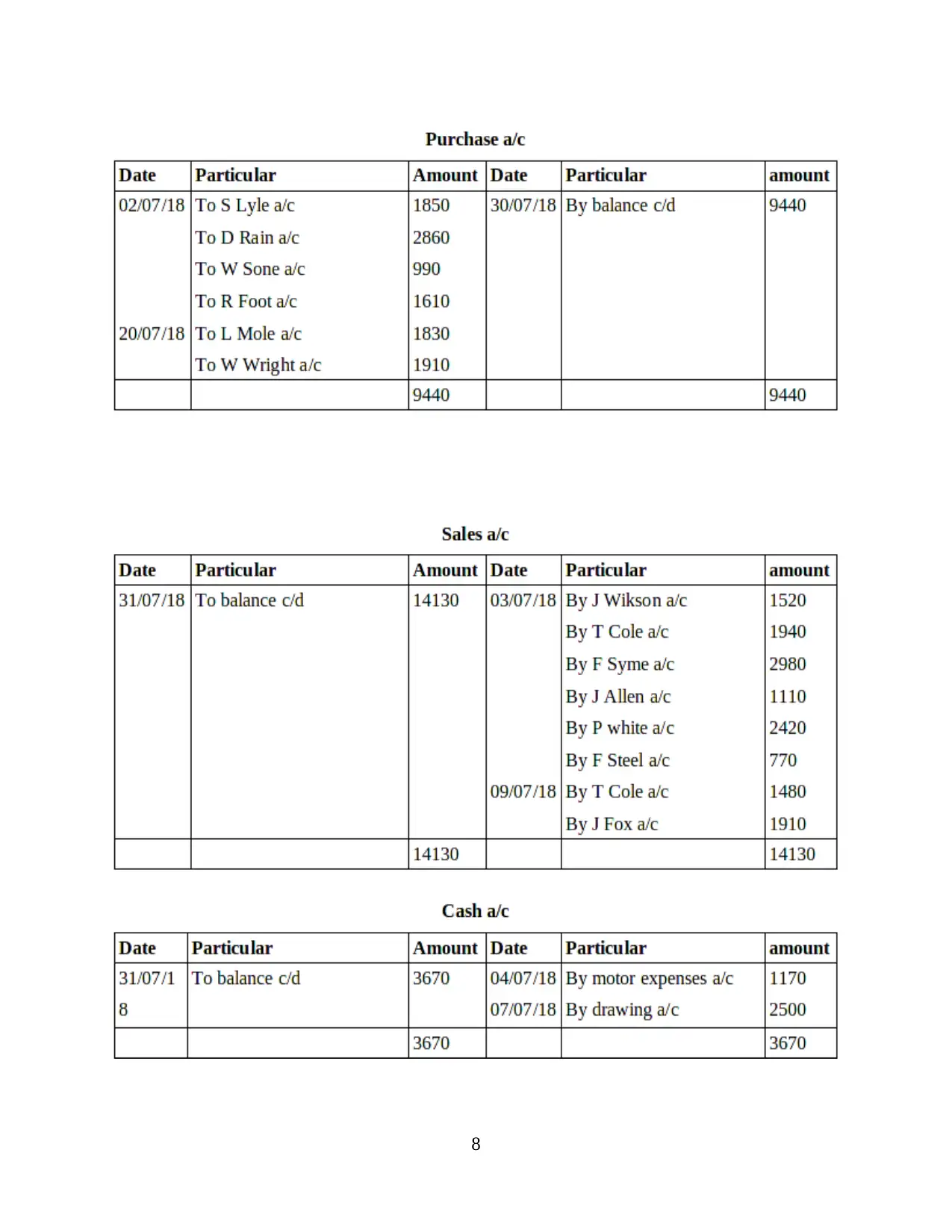
8
Paraphrase This Document
Need a fresh take? Get an instant paraphrase of this document with our AI Paraphraser
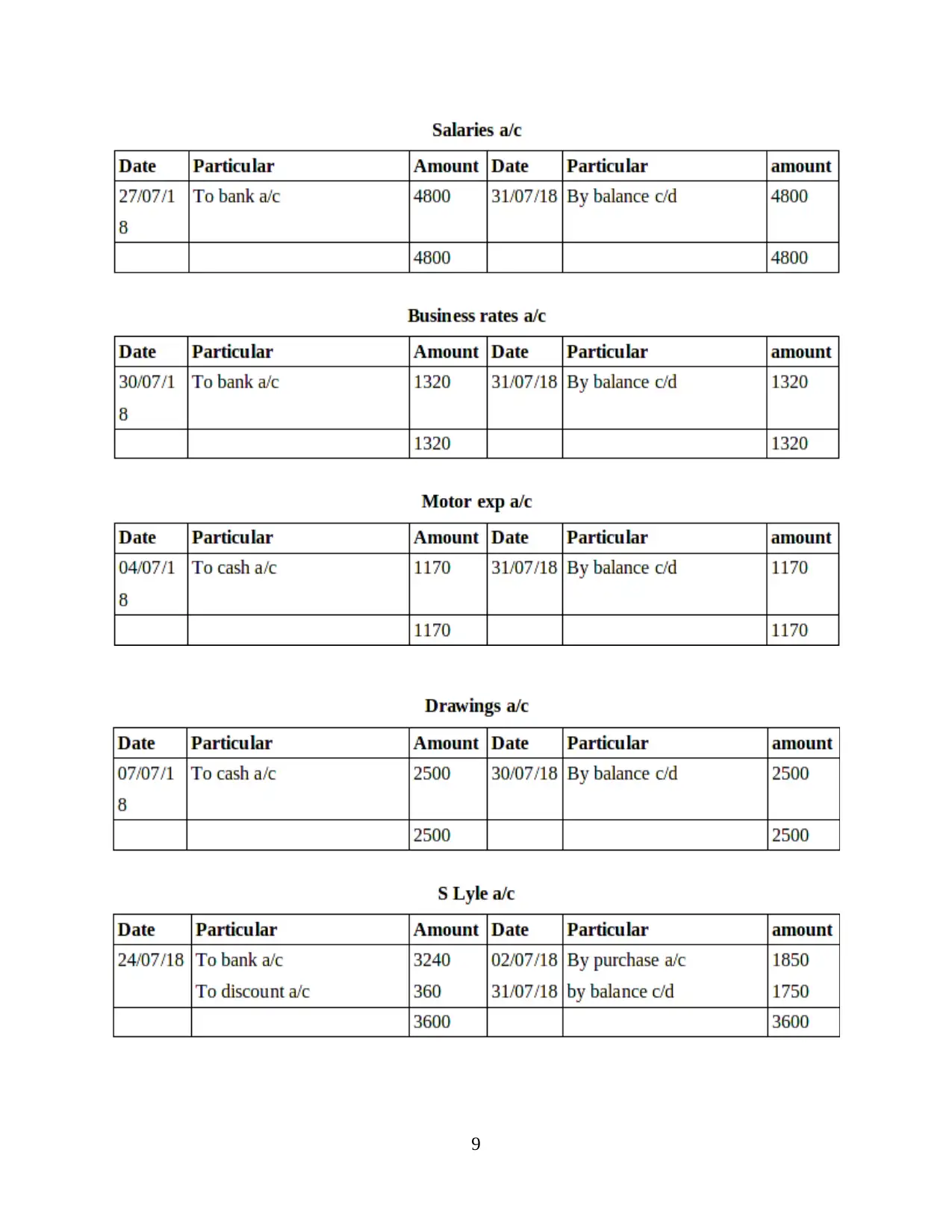
9

10
⊘ This is a preview!⊘
Do you want full access?
Subscribe today to unlock all pages.

Trusted by 1+ million students worldwide
1 out of 28
Related Documents
Your All-in-One AI-Powered Toolkit for Academic Success.
+13062052269
info@desklib.com
Available 24*7 on WhatsApp / Email
![[object Object]](/_next/static/media/star-bottom.7253800d.svg)
Unlock your academic potential
Copyright © 2020–2025 A2Z Services. All Rights Reserved. Developed and managed by ZUCOL.





